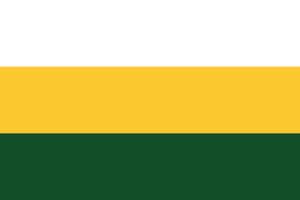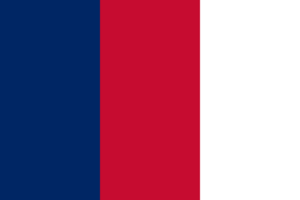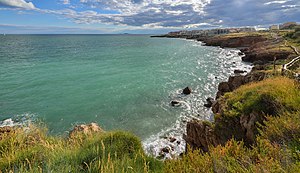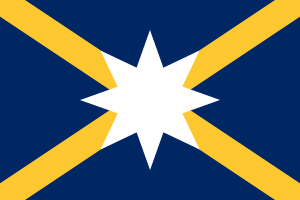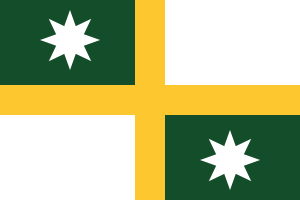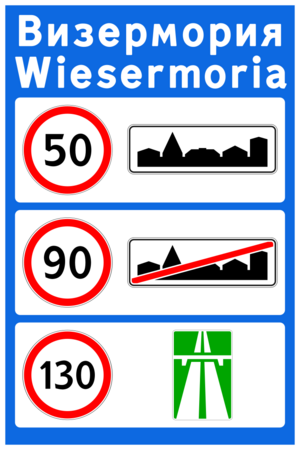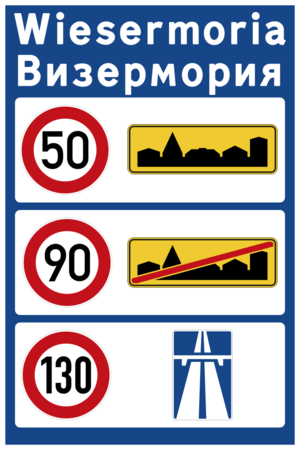Wiesermoria
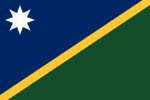
|
Republic of Wiesermoria Wiesermorische Republik/Визерморская Республика (German, Russian) Capital: Blauwitz, Sinegrad
Population: 15,000,000 |
Loading map... |
Wiesermoria is a country on the western edge of East Uletha. It has an area of 130,831 km2 and lies on an isthmus which is bordered by Ohemia and Suria to the north, the Ivirian sea to the west, Midistland to the south and the Kaspen sea to the east. Wiesermoria used to be two independent countries — Ivermoria and Breitwieserland until 1993, when they unified and formed a federation of two countries which consist of 10 states each. Due to this fact the country's capital cities are the two constituents' respective former capitals, the largest city is Sinegrad with a population of 6,000,000, the second largest is Blauwitz at 4,000,000 permanent residents. The population density is 115/km2. The official languages of Wiesermoria are German and Russian, with Turkish being a recognised minority language. Wiesermoria follows the Transulethan Timezone (+6) and does not employ daylight saving time.
History
Pre-history and Colonisation
What is now known as Wiesermoria has been a border region for most of modern human history. The area has been inhabited by nomads since ~2000 BC and was subject to constant raids and pillaging; due to this fact permanent settlements were few and far between until the 16th century AD, and with the advent of colonisation and disease prophylaxis the area was quickly divided between Germanic settlers in the east, Slavic settlers in the west and Turkish settlers from the Demirhan Empire in the south-west.
Post-colonial Era
The dispersed colonies eventually unified under two banners — Breitwieserland (1829) and Ivermoria (1794), both nations trading goods and exchanging cultures and languages with each other for a century until vast oil and coal deposits were discovered in Ivermoria in 1935 after which the neighbouring Suria invaded it. Over the course of the 20th century borders were closed off and fortified, forming an impassable barrier between the two formerly cordial nations. Breitwieserland received support from other democratic nations due to its immediate proximity to a belligerent leadership and proceeded to develop a strong, diversified capitalist economy.
Unification
Due to several Ivermorian revolts in the 1980s and 1990s, Suria eventually ceded independence after proving unable to keep propping up the socialist government in Ivermoria. Almost immediately after independence, the two countries voted to reunify, forming the Republic of Wiesermoria (Wiesermorische Republik/Визерморская республика) on 8/08/1993. At the present moment the country is still majority Russian-speaking in the west and German-speaking in the east, however both languages frequently take loanwords from each other and most citizens are proficient in both Russian and German.
Geography
 | |
|---|---|
| Geography of Wiesermoria | |
| Continent | Uletha (Central) |
| Population | 15,000,000 (2023) |
| Area | |
| • Total | 130,831.406 km2 50,514.288 sq mi |
| Population density | 115 km2 44 sq mi |
| Time zone | WUT+6:00 (TUT) |
Natural Geography
The nation's climate is mostly hemiboreal or Dfb using the Köppen climate classification, similar to Central and Eastern Europe, northeastern China and the eastern American-Canadian border region. Summer temperatures range from 21-28 °C, while winter temperatures stay between -5 to 5 °C, although frequently reach -15 °C. The landscape is characterised by rolling hills and sprawling ancient forests. The terrain becomes slightly mountainous in the central part of the country forming a barrier between the east and west halves of the country, however most of the country is relatively flat due to it being situated on a wide isthmus separating the Kaspen and Ivirian Seas. The climate becomes more Mediterranean (Cfa) on both coasts, having a landscape similar to that of northern California or Italy, with a gradual chaparral shrubland (Cfb) transition from the steppes.
Ivermoria
Breitwieserland
Human Geography
Wiesermoria is inhabited primarily by Russians in the west and Germans in the east. Because of the eastern part of the country being generally more habitable and having more rivers, it has a slightly larger population. Because of rapid urbanisation efforts by the socialist government, Ivermoria boasts large metropolitan centres which concentrate most of the region's population, which contrasts with the mostly suburban eastern cities.
Wiesermoria has an unequal development distribution due to it being two different countries until 1993; a stark contrast exists along the old Ivermorian-Breitwieserland border. The Ivermorian economy was mostly based on natural resource extraction and refinement such as coal, oil, chemicals, etc. As for transport, railways were the primary focus of the socialist government, highways being built primarily for local freight traffic. After unification, car ownership rates skyrocketed in Ivermoria, meaning severe congestion and low traffic safety were characteristic of the region until only recently; public transit in cities was modernised, new motorways were built to western standards, and the existing road network received drastic overhauls and repaved. On the other hand, Breitwieserland has always had a capitalist and free-market economy and thus had a plethora of industries such as electronics, automotive manufacturing, coal, and recently financial and service industries. Around the middle of the 20th century Breitwieserland began producing and importing vehicles on a much larger scale than Ivermoria, prompting the government to focus much more on providing efficient private and public transport links: the first Autobahn was opened in 1949, after which the motorway network has expanded considerably to mirror the road network density of other western nations. One of the first major infrastructure projects after unification was to construct a motorway-railway supercorridor between east and west Wiesermoria, in hopes of bringing more development and commerce to both sides. The country has unified traffic rules, however road signs and railway signals follow different standards in the east and west to this day.
Places
Cities
A city in Wiesermoria is a consolidated urban area with over 100,000 permanent residents. As of 2024, there are 8 cities in Wiesermoria, with Sinegrad, Chernorechensk, Shakhinsk and Myrodvinsk located in Ivermoria, and Blauwitz, Weydbach, Flussbronn and Walskirchen located in Breitwieserland.
Towns
Towns in Wiesermoria have between 10,000 and 100,000 permanent residents.
States
 | |
|---|---|
| Administrative divisions of Wiesermoria | |
| First-level | 20 области/Staaten (states) |
| Second-level | регионы/Regionen (regions) |
| Third-level | провинции/Provinzen (provinces) |
| Fourth-level | округи/Wahlkreise (constituencies) |
Largest cities | |
| • Sinegrad • Blauwitz • Shakhinsk • Weydbach | 6,000,000 4,000,000 1,000,000 800,000 |
Ivermoria
| State | Flag | Information | Description |
|---|---|---|---|
| Синеград (City of Sinegrad) |
|
Capital of Ivermoria, largest city in Wiesermoria. |
Breitwieserland
| State | Flag | Information | Description |
|---|---|---|---|
| Freistadt Blauwitz (Free City of Blauwitz) |
|
Capital of Breitwieserland and second-largest city in Wiesermoria. |
Government
| Government of Wiesermoria | |
|---|---|
| Parliamentary federation | |
| Capital | Blauwitz, Sinegrad |
| Head of state | |
| • President | Johann Stauber |
| • Prime Minister | Viktor Kerimsky |
| Legislature | Joint Parliament of Ivermoria and Breitwieserland |
| • Upper house | Executive Legislative Council |
| • Lower house | Great Electorate Assembly |
| Judiciary | United Court of Wiesermoria |
| Chairman of ELC | Yelena Vidlanskaya |
| Chairman of GEA | Heinz Lemberger |
Breitwieserland is a parliamentary federation with a ceremonial President as head of state. The government has a bicameral structure — the lower house has 400 seats and hosts delegates elected by each state (20 per state). The upper house has 60 seats (3 per state) where representatives are elected by the lower house.
Economy
 | |
|---|---|
| Economy of Wiesermoria | |
| Social market economy | |
| Currency | Wiesermorian Mark (ℳ︁) |
| Monetary authority | Blauwitzer Münze (Blauwitz Mint) |
| GDP (PPP) | 2024 estimate |
| • Total | $67.5 billion |
| • Per capita | $45,000 |
| HDI (2024) | very high |
| Principal exports | Automobiles, petrochemicals, electricity, rare earth metals, uranium |
| Principal imports | Industrial machinery, coal, iron, pharmaceuticals, bauxite |
Transportation
| Infrastructure of Wiesermoria | |
|---|---|
| Roadways | |
| • Driving side | Right |
| • Minimum age | 18 16 (with approved driving instructor) |
| • Maximum speed | Motorway: 130 km/h Rural: 90 km/h Urban: 50 km/h Living street: 20 km/h |
| Railways | |
| • Passing side | Right |
| • Gauge | Breitwieserland: 1435 mm Ivermoria: 1520mm |
| • Electrification | Overhead contact line (heavy rail/trams), third rail (metro/light rail) |
| • Maximum speed | 160 km/h (non-high-speed), 300 km/h (high-speed) |
| Mains electricity | 230 V, 50 Hz |
| Internet TLD | .wm/.bw/.iv |
Air
Wiesermoria hosts a number of international airports with regular flights to neighbouring countries.
| Airport | Code |
|---|---|
| Sinegrad | SGX |
| Blauwitz | BWZ |
| Shakhinsk | SXK |
Rail
Overview
Signalling
Wiesermoria uses PZB (Punktförmige Zugbeeinflussung) on all railways and LZB (Linienzugbeeinflussung) on high-speed lines.
High-Speed Rail
The highest speed limit that can be set on a railway without high-speed provisions is 160 km/h, however the railway still needs to meet some design requirements; otherwise, the speed limit is 140 km/h (120 km/h for freight trains). The rail speed limit of 300 km/h is found on Wiesermorian high-speed rail lines, such as the Sinegrad-Blauwitz High-Speed Mainline (Schnellfahrstrecke Sinegrad-Blauwitz/Высокоскоростная магистраль «Синеград-Блаувиц»). High-speed railways in Wiesermoria must have LZB signalling, large curve radii, adapted stations (safety barriers on adjacent platforms) and be electrified.
Road
| Road Class | Road Numbering Scheme | Route Shield | Function | Design Parameters (Breitwieserland) | Design Parameters (Ivermoria) |
|---|---|---|---|---|---|
| Autobahn/Автомагистраль (highway=motorway) | A### | High-quality and high-speed roads that carry primary road traffic. Motorways follow strict design requirements which enable the conveyance of high-speed traffic safely. Most motorways in Ivermoria have older, lower quality design standards which necessitate a 110 km/h speed limit. |
|
| |
| Kraftfahrstraße/Скоростная дорога (highway=trunk) | M### | High-quality and high-speed roads that carry primary road traffic. Lower quality than motorways and opted for in places with difficult terrain or in and around cities due to the lower design requirements and construction costs. All trunk roads are motorroads but not all motorroads are trunk roads. |
|
| |
| Hauptstraße/Дорога первой значимости (highway=primary) | ## | Most important roads in Wiesermoria — they connect the largest cities, ports, airports and other terminals together and form a connected network across the whole country without any isolated stretches of road.
In urban areas primary roads are the most important corridors in the city that bear the heaviest traffic loads and connect the centre with major suburbs, as well as connecting major districts. If a ring road is present then it acts as a primary road and no primary roads may exist inside the ring. |
|
| |
| Landesstraße/Дорога второй значимости (highway=secondary) | ### | Next most important roads in Wiesermoria — they connect primary roads together or cities/towns to primary roads as well as linking small cities and towns.
In urban areas secondary roads are those that are less important than primary roads and connect suburbs or smaller districts with each other. |
|||
| Kreisstraße/Дорога третьей значимости (highway=tertiary) | #### | Roads that are less important than secondary roads — they connect secondary roads together or towns to secondary roads as well as linking towns.
In urban areas tertiary roads connect small suburbs or quarters with the centre and with each other. |
|||
| Nebenstraße/Дорога четвёртой значимости (highway=unclassified/residential) | N/A | Roads that carry local traffic and aren't meant for heavy use. Residential roads are unclassified roads with the primary function of providing access to residential properties. | |||
| Wohnstraße/Жилая улица (highway=living_street) | N/A | Residential roads that have been traffic-calmed to prioritise creating a safe environment for pedestrians. Through traffic is forbidden from using these roads. Pedestrians have priority over other road users and may cross or walk along the carriageway at any point in which case they must be given way to. | |||
| Wirtschaftsweg/Просёлочная дорога (highway=track) | N/A | Roads that facilitate access to farms or forestry areas, usually unpaved. | |||
| Zufahrtsweg/Проезд прилегающей территории
(highway=service) |
N/A | Roads that facilitate access to adjoining road facilities as well as minor residential areas |
Route Numbering System
Wiesermoria uses a route numbering system where certain pre-defined corridors are assigned a number and zones are created. Zones 1 through 5 are located in Ivermoria and zones 6 through 9 are located in Breitwieserland. All minor roads are thereby numbered according to the zone they are located, with the zones starting to the north or west the parent road. The only exception to this rule is A1, which crosses many zones. A or M roads have a separate system where even numbers represent east-west routes and odd numbers represent north-south routes, with the exception again being A1; the numbers increase from west to east. Branch A or M roads take the number of their parent route and add '0#' or '#' to make a three-digit route.
Speed Limits
The default speed limits for motorcars, motorcycles and goods vehicles are as follows:
- 130 km/h on motorways (WM:motorway)
- 90 km/h outside urban areas (WM:rural)
- 50 km/h inside urban areas (WM:urban)
- 20 km/h on living streets or inside service areas (WM:living_street)
The default speed limits for vehicles pulling a trailer or HGVs are as follows:
- 90 km/h on motorways
- 70 km/h outside urban areas
- 50 km/h inside urban areas
- 20 km/h on living streets or inside service areas
The default speed limits for buses are as follows:
- 100 km/h on motorways
- 80 km/h outside urban areas
- 50 km/h inside urban areas
- 20 km/h on living streets or inside service areas
HGVs are defined as cargo vehicles with a GVWR of over 3.5 tons while those with a GVWR below or equal to 3.5 tons are classed as goods vehicles. HGVs, vehicles pulling a trailer and buses must not exceed their motorway speed limit if the posted limit is higher.
Buses without seatbelts (such as city buses) and school buses are limited to 60 km/h. When towing another motor vehicle, the speed limit is 50 km/h.
The official speeding tolerance is 8% for speeds below 100 km/h and 8 km/h above 100 km/h, however if the driver is found to have been speeding even by 1 km/h at the time of a crash, they will be held liable most of the time.
| Speed Limit (km/h) | Breitwieserland | Ivermoria |
|---|---|---|
| Selected high-quality stretches of motorway (must have at least 3 lanes in each direction, an electronic traffic management system, regular speed enforcement and other additional safety features | Not used | |
|
Default motorway limit (in practice only high quality (Breitwieserland standard) sections of motorway have this speed limit) | |
| Medium quality rural motorroads | Dangerous sections of motorway | |
| Low quality rural motorroads |
| |
|
| |
| Default rural limit, road must have provisions for vulnerable road users (pedestrians, equestrians, cyclists) |
| |
|
| |
|
| |
|
| |
|
| |
|
| |
|
| |
| Default living street limit, may not be set outside of living streets or access roads | Default living street limit, may not be set outside of living streets or access roads |
Traffic Rules
11. Overtaking and Meeting Traffic
11.1. Before beginning to overtake, the driver should check whether the adjacent lane is free for a sufficient distance, and that there will not be any inconveniences caused to traffic by overtaking.
11.2. It is forbidden to overtake when:
- The driver of the vehicle about to be overtaken is overtaking or going around an obstacle;
- The driver of the vehicle about to be overtaken has turned on a left turn signal;
- It is impossible to return back to the driving lane without causing a danger to oncoming traffic or an inconvenience to the vehicle being overtaken.
Do not assume that if the vehicle in front has started overtaking, it is safe to overtake.
11.3. The driver of the vehicle being overtaken is forbidden to speed up or interfere with the overtaking manoeuvre in any other way.
11.4. Overtaking is forbidden:
- In light-controlled, equivalent or in uncontrolled junctions when not approaching from a priority road;
- Over pedestrian crossings;
- Over railway crossings and 100 metres before them;
- In two-lane two-way tunnels;
- At the top of hills, on dangerous turns or on other stretches of road with reduced visibility.
11.5. Outside of built-up areas, the driver of a motor vehicle which cannot exceed 30 km/h by design or due to its condition should drive the vehicle closer to the right edge of the carriageway and stop to let traffic behind pass at reasonable times.
11.6. In case the road is too narrow to accommodate two oncoming vehicles and no priority signs are installed, both should slow down and find a solution (either by reversing or driving on the shoulder). When moving up or down a hill, the vehicle moving uphill has priority.
11.7. When overtaking pedestrians, cyclists, riders of domestic animals, or other vulnerable road users, drivers of motor vehicles must allow for a distance of 1.5 metres in built-up areas and 2 metres outside of built-up areas, and overtake at no more than 50 km/h (20 km/h in the case of overtaking riders of domestic animals).
12. Stopping and Parking
12.1. Stopping and parking a vehicle is only allowed on the right side of the road on the shoulder (as close as possible to the right edge of the carriageway in the absence of a shoulder), or on the pavement in the presence of a sign.
Stopping and parking on the left side of the road is only allowed in built-up areas on two-lane two-way roads without tram tracks on the carriageway and on one-way roads (HGVs with a maximum weight rating of over 3.5 tons may only stop on the left of one-way roads to load or unload).
12.2. Parked vehicles should be arranged in one row parallel to the edge of the carriageway. Single-tracked vehicles may be arranged in two rows.
12.3. Parking for the purpose of a prolonged rest period outside a built-up area should only be done in special areas or off-road.
16. Motorway Regulations
16.1. On a motorway, it is forbidden to:
- Walk (except when exiting a vehicle in an emergency), cycle, ride or lead a domestic animal, ride a moped, drive a tractor or other agricultural machinery, drive a vehicle which cannot exceed 60 km/h by design or due to its condition;
- Drive a HGV with a maximum weight rating of over 3.5 tons to the left of lane 2;
- Stop or park a vehicle outside of a signed area (except in an emergency);
- Make a u-turn or enter the central reservation;
- Drive a vehicle in reverse.
16.2. In the case of an emergency stop, the driver of the vehicle, after discovering a fault, should attempt to steer the vehicle onto the shoulder, or at least as far right as possible. After stopping, the driver must place a warning triangle on the shoulder at least 150 and no more than 300 metres behind the vehicle. After doing so the driver should exit the carriageway and call for assistance.
16.3. This section also applies to roads reserved for motor vehicles.
24. Additional Requirements for Cyclists and Moped Riders
24.1. Cycling on a pavement is forbidden. The movement of cyclists above the age of 14 must be on cycle paths if provided, unless:
- The cycle path is of insufficient quality or condition for the type of bicycle;
- It is impossible or impractical to continue the cyclist's journey via the cycle path;
- The use of the cycle path presents danger to other road users;
- The width of the bicycle due to its design or payload exceeds 1 metre;
- The cyclist is part of an organised cycle group.
If any of the above conditions are met, cyclists may use the carriageway or shoulder. It is recommended to stay towards the right side to allow other vehicles to overtake when safe and stay towards the centre of the lane when overtaking is dangerous. If cycle areas or lanes are provided, it is recommended to use them if it facilitates a safer journey for the cyclist.
24.2. The movement of cyclists between the ages of 7 and 14 and anyone accompanying must be on cycle paths or pavements, with preference given to cycle paths.
24.3. The movement of cyclists below the age of 7 and anyone accompanying must be on pavements.
24.4. An organised cycle group should be organised in two columns by default. The group should be split up into rows of 10 and allow a sufficient distance between for a motor vehicle to fit when overtaking the group. The group must be organised in one column if the width of the bicycles due to their design or payload exceeds 0.75 metres or if the width of the road is insufficient to allow a motor vehicle to overtake (less than 6 metres).
24.5. It is forbidden to cycle across an uncontrolled pedestrian crossing. When crossing the carriageway outside of crossings, the cyclist must give way to traffic already on the carriageway.
24.6. Moped riders are forbidden from using cycle areas, lanes or paths unless a sign states otherwise, in which case priority must be given to cyclists and the moped's speed must not exceed 30 km/h.
24.7. At nighttime or reduced visibility inside built-up areas and at all times outside built-up areas, cyclists and moped riders are required to wear clothing with retro-reflective elements and a red light on the back and a white light on the front of the bicycle or moped. The clear visibility and function of these devices must be ensured.
Water
Wiesermoria's history is inexorably tied to the seas. Since the first invention of sailing, the inhabitants of this land used the sea for trade, exploration and warfare. The Ivirian sea is a major host of trade due to having easy access to the Asperic ocean, and thus Sinegrad features the largest port facility in the country. The Dvizna is a major river which is wide enough for cargo ships to traverse up to Shakhinsk. Breitwieserland's colonial history is also closely tied with maritime endeavours.
